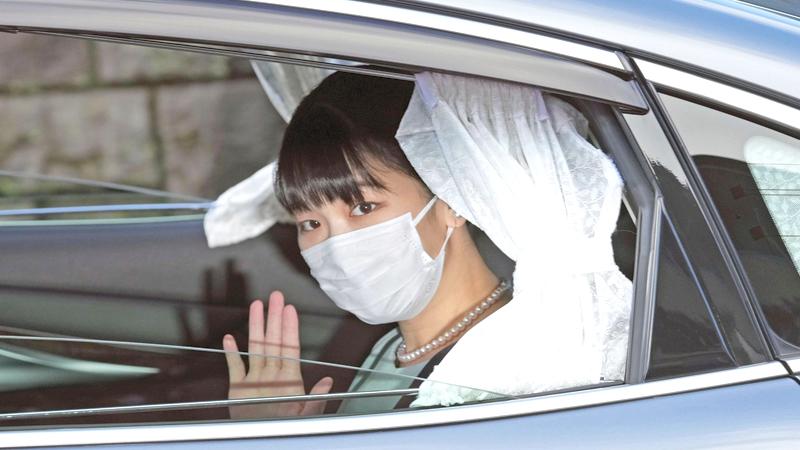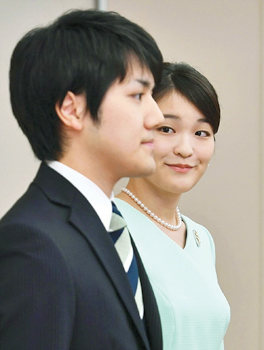
Japan’s Princess Mako has married her college sweetheart Kei Komuro - thus losing her royal status.
Under Japanese law, female imperial family members forfeit their status upon marriage to a “commoner” although male members do not.
She also skipped the usual rites of a royal wedding and turned down a payment offered to royal females upon their departure from the family. She is the first female member of the royal family to decline both.
The couple is expected to move to the US - where Komuro works as a lawyer - after marriage. The move has drawn inevitable comparisons with British royals Meghan Markle and Prince Harry, earning the newlyweds the nickname “Japan’s Harry and Meghan”.
Hairstyle
Like Markle, Komuro has come under intense scrutiny since his relationship with Mako was announced. He was most recently criticised for sporting a ponytail when he returned to Japan.
Some tabloid newspapers and social media users felt his hairstyle - seen as unconventional in Japan - was unbecoming of someone set to marry a princess. There was also a protest on Tuesday against the couple’s marriage.
 At a press conference on Tuesday, Mako said she apologised for any trouble brought to people by her marriage.
At a press conference on Tuesday, Mako said she apologised for any trouble brought to people by her marriage.
“I am very sorry for the inconvenience caused and I am grateful for those... who have continued to support me,” she said, according to an NHK report. “For me, Kei is irreplaceable - marriage was a necessary choice for us.”
Komuro added that he loved Mako and wanted to spend his life with her.
“I love Mako. We only get one life, and I want us to spend it with the one we love,” said Komuro. “I feel very sad that Mako has been in a bad condition, mentally and physically, because of the false accusations.”
Princess Mako left her Tokyo residence at around 10 local time on Tuesday to register her marriage, bowing several times to her parents, Crown Prince Fumihito and Crown Princess Kiko. She also hugged her younger sister before she left, news outlet Kyodo reported.
There has been excessive media coverage around the couple over the years, which has caused the princess to suffer from post-traumatic stress disorder, the Imperial Household Agency (IHA) had earlier said. Her relationship has been met with controversy in the country.
On Tuesday, people were pictured protesting against the marriage in a Japanese park.
Many slogans appeared to bring up financial issues around Komuro’s family - specifically his mother.
The former princess got engaged to Komuro in 2017 and the two were set to wed the following year. But the marriage was delayed following claims Komuro’s mother had financial problems - she had reportedly taken a loan from her ex-fiancé and not paid him back.
The palace denied the delay was linked to this, though Crown Prince Fumihito said it was important for the money issues to be dealt with before the couple got married.
According to the BBC’s Tokyo correspondent Rupert Wingfield-Hayes, the real reason for the animosity towards Komuro seems to be among some conservative Japanese who believe he is not a worthy partner for a niece of the emperor.
Komuro - who has received a job offer from a top New York law firm - comes from humble origins, and local tabloids have spent years digging dirt on his family, including the allegations against his mother.
The reaction to Princess Mako and Kei Komuro’s relationship by some media and people in Japan, has highlighted the pressure women in Japan’s imperial family face.
The Imperial Household Agency has said Princess Mako suffered from post-traumatic stress disorder because of the harsh criticism from the media and on social media around her engagement since it was announced nearly four years ago.
She is not the first woman in the Japanese royal family to be affected this way.
Her grandmother Empress Emerita Michiko temporarily lost her voice nearly 20 years ago when criticised by the media as being somehow unfit to be the Emperor’s wife. Her aunt-in-law Empress Masako, suffered depression after she was blamed for failing to produce a male heir.
Royal women have been forced to strictly adhere to certain expectations - they must be supportive of their husbands, produce an heir, and be a guardian of Japan’s traditions. If they fall short they are savagely criticised.
This is also true of Princess Mako, who said she would give up her royal status. But even that has not been enough to stop the attacks on her, her husband, and their marriage.
In 2017, when Mako, then a Japanese princess, announced her engagement to a former classmate, Kei Komuro, she said he had won over her heart with “his bright smiles like the sun”.
The two had met five years earlier when they were both university students, and shared their plans to wed the following year. It meant the princess would become an ordinary citizen as female imperial family members forfeit their royal status upon marriage to a commoner.
Their smiles won over a country where the imperial family is closely scrutinised and its members are expected to be a guardian of traditions. The intense media coverage was mostly positive.
But that quickly changed.
Two months later, the first reports emerged about an alleged money dispute between Komuro’s mother and her former fiancé, who claimed mother and son had failed to repay a debt to him.
Public perception soured. With the official explanation that the couple needed more time to arrange their ceremony, their wedding ended up postponed.
The former princess, who is now known as Mako Komuro, is the first child of the current emperor’s younger brother, Prince Akishino, and his wife, Princess Kiko. Born on 23 October 1991, she initially followed royal tradition and attended the elite Gakushuin School, where members of the imperial family usually study.
Master’s degree
But she broke with custom by leaving the institution for her university studies. Mako attended Tokyo’s International Christian University, where she studied art and cultural heritage, and spent a year at the University of Edinburgh. Later, she earned a master’s degree at the University of Leicester, an experience she said was “wonderful”.
People close to Ms Mako described her as an independent and friendly woman who had pursued a career while performing imperial duties, a profile by Japan’s Kyodo news agency said.
She first met Komuro, who was also born in 1991, at a meeting of students planning to go abroad in 2012. His humble origins meant that tabloids spent a long time digging dirt on his family. Amid the scandal in 2018, he moved to New York to study law at Fordham University, and the couple reportedly kept in touch through the internet.
He only came back to Japan last September, a return that was not without controversy. Komuro was dressed casually and sporting a ponytail, which for many was another proof that he was not fit to marry the then-princess.
Finally, in October, the couple got married. Mako skipped the usual rites associated with a royal family wedding, and turned down a traditional payment of about US$ 1.3m given to a female member of the royal family upon their departure from the household.
It was another break from tradition, as Mako became the first woman to do so.
Questions over Komuro’s finances remain, despite him saying that the money at the centre of the reports - about US$ 35,000 - had been a gift not a loan but that he would pay a settlement. At least one protest was held at their wedding day, which included placards saying “Protect our household” and “The imperial family is the soul of Japan”.
The excessive press coverage as well as the relentless attacks on social media have had an impact on Mako’s mental health, and she is now suffering from post-traumatic stress disorder, according to the Imperial Household Agency.
Mako is expected to remain in Tokyo for some time preparing for the move, according to a news agency. This includes applying for the first passport of her life. - BBC
